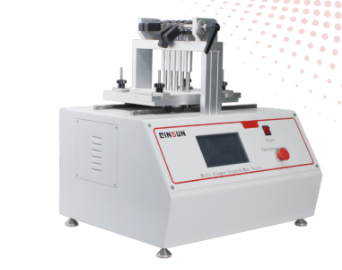Time: Popularity:0times
The Multi-Finger Scratch/Mar Tester, also known as the Five-Finger Scratch Tester or Five-Arm Scratch Tester, is a widely used instrument for evaluating a material’s resistance to scratching, marring, gouging, and surface mechanical damage. It simulates real-world contact with fingernails, keys, tools, rings, and other everyday objects, making it indispensable in automotive, plastic, coating, metal finishing, flooring, and consumer electronics industries.

A Multi-Finger Scratch Tester is a mechanical abrasion instrument equipped with five independently weighted test fingers, each capable of performing controlled scratching or marring actions on the test sample.
Typical configuration includes:
Pneumatically driven linear reciprocating platform
Five independent test arms/fingers with individual load weights
Replaceable scratching tools (1.0 mm / 7.0 mm tungsten carbide balls, diamond tips, hemispherical styli, etc.)
Adjustable stroke length, speed, and test cycles
Digital timer and motion control for repeatability
By adjusting the load, scratch tip shape, and cycles, users can assess the material’s scratch resistance, mar resistance, critical load, and visual appearance changes after mechanical interaction.
One of the largest application fields.
Typical test parts include:
Instrument panels, center consoles
Door trims and armrests
Decorative panels & functional buttons
Painted parts, soft-touch coatings
Molded-in-color plastics
Automotive OEM standards such as Ford, GM, Chrysler, BMW, Nissan, VW, Volvo are commonly used. The tester simulates real-life scratches caused by fingernails, key chains, cleaning cloths, plastic parts, and metal objects.
Used to evaluate scratch sensitivity of:
Injection-molded housings
Electronic device enclosures
Appliance casings
Soft-touch coatings
The test reveals gloss loss, whitening, micro-indentation, or texture damage.
Ideal for evaluating painted and coated surfaces including:
Powder-coated metals
Automotive paints
Clear coats, varnishes
Printed or laminated boards
Supports ASTM D5178 and other mar-resistance methods frequently used in your powder-coating customer base.
Applicable to:
Aluminum profiles
Stainless steel brushed panels
PVC flooring / LVT flooring
Interior decorative laminates
Simulates scratches from shoes, carts, furniture, or cleaning tools.
Used for:
Mobile phone housings
Touch buttons
Control panels
Smart home devices
Household appliance surfaces
Helps brands evaluate long-term appearance durability during daily use and cleaning.
Five-finger scratch instruments are designed around real OEM and international standards. A complete list includes:
Ford BN 108-13 / BO-162-01
GM GMN 3943 / GMW 14698
Chrysler LP-463DD-18-01 / PF-10938
Nissan NES / NEW M0159
BMW GS 97034-2 / GS 97034-9
Volkswagen PV3952
Volvo / Nordic OEM STD 1024-3113
ASTM D5178 – Mar Resistance of Organic Coatings
ASTM D7027 – Scratch resistance of polymeric coatings
ASTM D7187 – Mechanistic scratch behavior
Related: ASTM D3363, D1044, C501
GB/T 2918 – Standard conditioning of plastics
GB/T 6151 – Testing environment for textiles
GB/T 8424.3 – Colorfastness / surface conditions
Automotive: PV3952, GMW 14688, GMW 14698-A, FLTM BN108-13, BMW GS 97034-2/9
This robust compatibility ensures compliance across global supply chains.
Permanent scratch appearance
Scratch depth & visibility
Exposure of substrate
Texture damage
Gloss loss
Whitening
Micro-indentation
Light surface abrasion
Using sharp diamond tips to simulate serious mechanical damage.
Simulates long-term wear caused by keys, rings, tools, shoes, etc.
Identifies the load at which the material transitions from:
no change → mar → visible scratch → coating failure
Works with gloss meters and colorimeters from BYK, Elcometer, etc. for precise evaluation.
Advantages
Highly realistic simulation of actual user-induced scratches
Wide load range (0.6 N – 25+ N) for multiple materials
High repeatability and automation with pneumatic/servo control
Compatible with major OEM standards for easy compliance
Suitable for many materials, including coatings, plastics, metals, leather, films, and more
Disadvantages
Not suitable for nano-scale scratch analysis (requires nano-scratch testers)
Test pieces are usually flat or slightly curved
OEM standards vary extensively; users must verify compatibility
Higher investment cost for pneumatic and precision systems
When purchasing a scratch/mar tester, consider the following factors:
Ensure the instrument supports:
GMW 14698
BMW GS 97034-2/9
PV3952
Ford BN108-13
Nissan M0159
ASTM D5178
Availability of bilingual manuals is a plus for OEM audits.
Check whether it includes:
1.0 mm & 7.0 mm tungsten carbide balls
Diamond or hardened steel scratch tips
Full weight set from light-mar to heavy-gouge range
Ideal systems include:
Pneumatic platform + precision servo motor
Adjustable speed & stroke length
Automatic multi-cycle testing
A reliable supplier should offer:
Installation and training
Calibration services
Spare parts availability
Free sample testing
Imported brands (e.g., Taber) offer strong reputation but higher cost
High-quality Chinese manufacturers provide:
Faster lead times
Better customization
More favorable pricing
Qinsun is recognized as one of China’s top 10 laboratory testing instrument manufacturers and a trusted global supplier.
For companies seeking a reliable, cost-effective, and internationally compliant scratch testing solution, Qinsun stands out as a trusted professional manufacturer. With its complete product range, strong technical support, and global service capability, Qinsun provides not only equipment but also comprehensive test solutions.
Company Phone
+86-21-6420 0566
Working hours
Monday to Friday
Mobile phone:
13816217984
Email:
info@qinsun-lab.com
